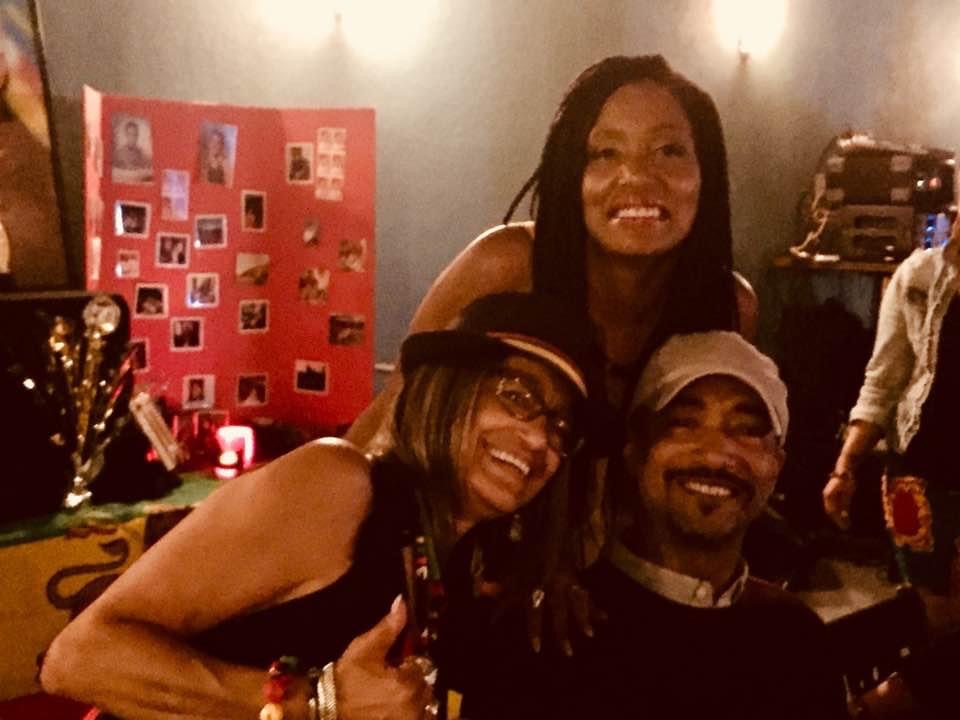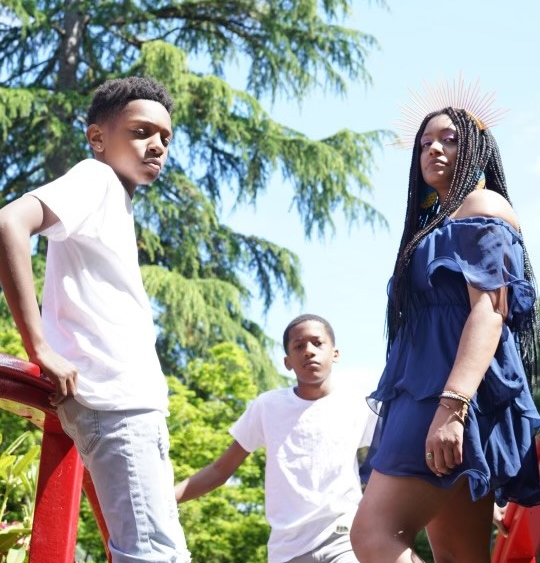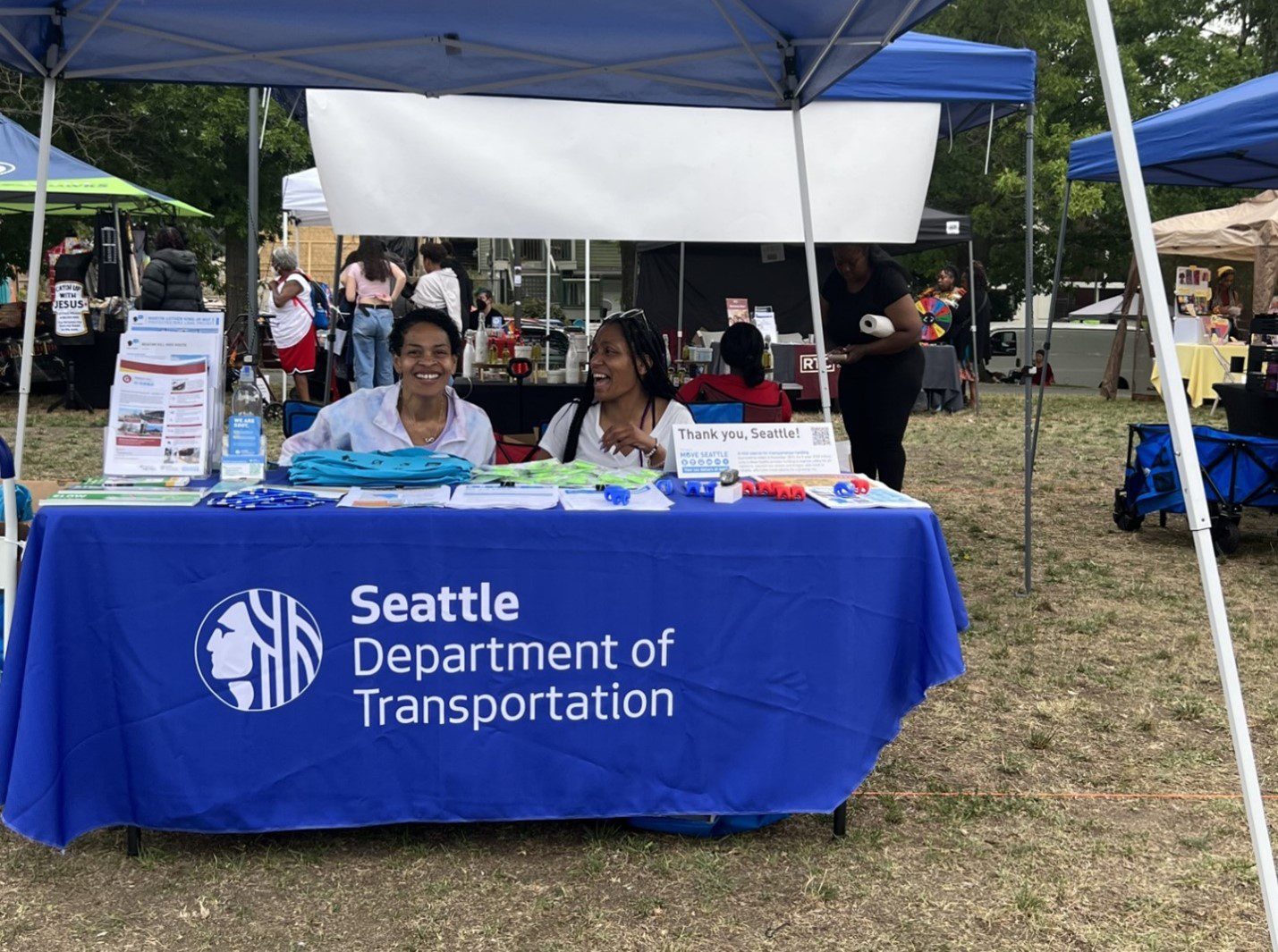 Cheyenne (top middle) with her mother Judith Hightower (left) and brother Damon Hightower (left) who works with the Seattle Department of Construction and Inspections. Photo credit: Cheyenne Montgomery
Cheyenne (top middle) with her mother Judith Hightower (left) and brother Damon Hightower (left) who works with the Seattle Department of Construction and Inspections. Photo credit: Cheyenne Montgomery Blog stats: 1,000 words | 5-minute read
We’re hosting a series of Roadside Chats with employees on our team at the Seattle Department of Transportation (SDOT) as we celebrate Black History Month 2024. We hope you enjoy this conversation with Cheyenne Montgomery, who is an Administrative Business Partner in SDOT’s Director’s Office.
Please tell us about yourself. What’s your current role at SDOT? What do you enjoy most about your role?
I am a boy mom who loves sports, true crime, fashion, reading, and a little adventure sometimes. After work or on weekends, you can usually find me in a gym or field or dreaming of warm weather and a beach. I’m third generation, born and raised in Seattle. Growing up in the Central District (CD) was centered around community. Most of my family members are former or current City of Seattle employees.
My current role at SDOT is the Administrative Business Partner for the Director’s Office. Which means I do a little of everything to keep the Director’s Office and SDOT going. I enjoy connecting with people the most. I get to meet people from every department in and out of SDOT and the City of Seattle. I’m an expert relationship builder – you never know what knowledge someone else possesses that you may need in the future. I enjoy helping folks find a solution because it’s usually to solve a problem when they come to me, and I’m the key.
Can you share the personal significance Black History Month holds for you?
Growing up, I was the kid who asked many questions. My mom was in law school and fostered my questioning by teaching about Black history that wasn’t taught in schools. I wasn’t allowed to wear Nike, eat at McDonald’s, or drink Coca-Cola, unlike most kids, because they participated in the apartheid. On weekends, we would protest all over Washington. I also had handmaid Barbie dolls of Winnie and Nelson Mandela. My favorite book growing up, “Black is Beautiful,” had black and white pictures of every black object and ended with a black and white photo of a young Black kid. Just a reminder that Black is beautiful. I also learned the meaning of and could recite the pan-African flag colors by the time I was 7. Red is for blood, green is for money, and black is for the land. ❤️🖤💚
It’s important to me to instill teachings about Black history and family history that were taught to me and pass them down to my boys. Both my grandmothers arrived in Seattle on the same train, the same day from Atlanta during WWII, and were Rosies at Boeing. We lived in the CD (once called the Colored District because that was the only neighborhood where Black folks could buy houses). My mother was one of the first Black female judges in Seattle, and her name had to get 5% in the primary to get on the general ballot. She got 30% which got her on the ballot, and she received 70% in the general election. She won by a landslide.
My stepdad was one of four Black athletes on the UW Husky football team in 1969 who are members of the UW Hall of Fame because they were suspended after refusing to pledge personal loyalty to their coach, Jim Owens, and subsequently remained off the team until the Apple Cup of that year. For me and my family, Black History is all year round, but this is a time to celebrate with others and share with others who might not be aware of the accomplishments Black folks have made for this country.

How do you see your contributions at SDOT helping to create positive impacts at work, within the community, or in other ways?
Working at SDOT is a way to contribute to the service my grandmother instilled in me at a young age. The community I grew up in has been hit hard by gentrification, with the folks still there trying to hold on and flow with the changes. It’s my job as a representative of the Black community to keep the elders and others informed on where to report potholes and where the SDOT and community events are so that we have a wide range of participants.
When I arrived at SDOT in 2022, I ensured that SDOT contributed to the Conference of Minority Transportation Officials (COMTO). I had been very involved in previous government agencies, and as the person who is behind the scenes of the Memberships & Sponsorships program at SDOT, I made sure we paid our dues and continued to use COMTO as a resource by posting our job openings on their website.
Do you have any personal stories or experiences that have shaped your perspective on Black history and its significance in the context of government work?
I worked at the SDOT booth at the Umoja Festival this past summer and noticed that more community members were coming to our booth to ask questions and comment about the work that SDOT is doing because they had someone who looked like them. A lot of the government agency booths didn’t have folks in the booth that matched the environment and groups. We were the ear to the streets and the buffer between the community and SDOT, and folks were very appreciative of that.
Working at SDOT gives me the satisfaction that I’m helping the community through transportation and service. I know that I’m my ancestor’s wildest dreams. In the words of my father, who passed away last year, “Stay Black!”
